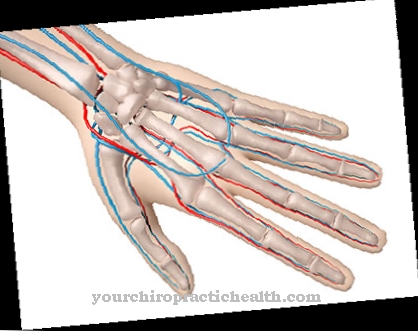A Sinus infection or Sinusitis is an inflammation of the lining of the sinuses. It is mostly triggered by viruses or bacteria and can take an acute or chronic form. Typical symptoms are runny nose and stabbing and throbbing pain in the forehead and eyes.
What is a sinus infection?

© Henrie - stock.adobe.com
A Sinus infection is also called in medicine Sinusitis designated. The paranasal sinuses in particular are inflamed. A sinus infection is usually acute, but it can also develop into a chronic sinus infection.
Inflammation of the sinuses is quite common. In acute illness, the maxillary sinus, frontal sinus, ethmoid or sphenoid sinus in the skull are usually affected. With chronic sinusitis, the disease usually only spreads to the ethmoid or maxillary sinus. In rare cases, all of the sinuses are inflamed. This is then known as pansinusitis or polysinusitis.
causes
The causes of a Sinus infection A distinction is made between acute and chronic causes and will now be examined in more detail below.
Acute sinus infection
After a sore throat or runny nose it can lead to a Sinus infection come. Viruses are considered to be the triggers that cause the mucous membrane to swell over the course of the process and shift the foci of inflammation towards the sinus entrances. A second bacterial infection then occurs. Streptococci, pneumococci and the bacteria Haemophilus influenzae play a central role here.
In addition, existing nasal polyps, an enlarged nasal conch or a crooked nasal septum promote inflammation. A diseased tooth root or an inflammation caused by a pulled tooth is also possible as a supporting trigger. Acute sinusitis occurs more rarely after a bath or swimming, where pathogens in the water can lead to inflammation of the sinuses.
Chronic sinus infection
The causes of chronic sinus inflammation are usually insufficient ventilation of the sinuses, which are then narrowed. Likewise, a crooked nasal septum, nasal polyps and enlarged nasal concha are the triggers. Aggressive bacterial pathogens coupled with a weakened immune system are also possible. Since the transport of mucus is hindered over a long period of time, the bacteria can lead to chronic inflammation.
Symptoms, ailments & signs
The acute inflammation of the sinuses begins with a runny nose, which does not subside in the usual time. Instead, the nasal secretions solidify, the nose is blocked and cannot be blown out. Nasal breathing is no longer possible, and the senses of smell and taste are restricted. In addition, there is a feeling of pressure in the head and face, which increases and becomes throbbing when the person concerned bends forward, stands up from sitting or hops.
Sneezing and coughing also make the pain worse. The skin of the face can become sensitive to touch. Which of the sinuses is inflamed can be seen from the areas in which the pain is located. With sinusitis, the forehead and eyes hurt.
If the maxillary sinuses are diseased, the pain is in the cheekbones and upper jaw. These symptoms sometimes feel like a toothache and can even spread to the lower jaw. If the pain is felt in the temples and back of the head, the inflammation is in the ethmoid cells or the sphenoid sinuses.
If the sinusitis is left untreated, visual disturbances, extreme headaches or sensitivity to light can occur. In addition, if left untreated, there is a risk that the disease will become chronic. With this course, the existing pain diminishes over time, but the general condition worsens and performance decreases. The patient feels sick.
Course of disease
The course of a Sinus infection can be positive if the disease is recognized and treated in good time. An acute sinus infection is usually treated quickly by your family doctor. If you have a chronic disease, polyp removal or surgery on a crooked inner wall of the nose could be considered.
Complications can occur in the form of laryngitis or chronic pharyngitis. Also acute bronchitis.In severe and untreated cases, the frontal sinus may even break through, which can then cause the skin to become inflamed. When combined with an inflammation of the maxillary sinus, the inflammation may break through to the eye socket. Sometimes this leads to irreversible vision loss or visual disturbances.
If the sinus infection affects the brain, it can lead to meningitis, neck pain and brain abscesses. This can lead to lifelong neurological disorders. Paralysis and seizures are particularly noticeable here.
A sinus infection can cause various complications. However, these rarely show up with professional therapy. Without appropriate treatment, however, there is a risk of serious effects.
Complications
The main risk of complications in sinusitis is if the inflammation persists over a long period of time. It can also take a chronic course or start again and again. Chronic sinusitis triggers repeated acute attacks.
As a result, concomitant diseases such as acute bronchitis, inflammation of the throat or laryngitis also show up. In such cases, doctors speak of a sinubronchial syndrome. Another potential sinus infection problem is its spread to adjacent tissues. For example, the pathogens can cause mild periosteum inflammation or severe inflammation of bone tissue and soft tissue.
In some cases, sinusitis also threatens serious complications such as meningitis (meningitis) or even encephalitis (inflammation of the brain). These sequelae make themselves noticeable through sensitivity to light, intense headaches, pronounced fatigue and irritability. If these signs occur, immediate treatment must be given in a hospital.
In children in particular, there is a risk that the sinus infection will spread to the eye sockets. The eyelids swell and redden. Antibiotics are given for treatment. It is not uncommon for an operation to be performed. In extreme cases, there is a risk of blood poisoning (sepsis), which can be life-threatening.
When should you go to the doctor?
A sinus infection usually disappears on its own with appropriate rest. However, it is extremely uncomfortable and a doctor can relieve the symptoms. Persistent and persistent colds should be presented to a doctor. If there is also impairment of taste perception and pain in the face or head, a doctor is required.
If the person concerned cannot clean his nose adequately, the help of a doctor should be sought. Disturbances in breathing, difficult oxygen supply and nasal vocalizations give cause for concern. The person concerned needs medical help so that there is no acute condition or the development of various sequelae. Visual disturbances, sensitivity to the effects of light as well as concentration and attention deficits should be discussed with a doctor.
Toothache or a feeling of pressure inside the head are perceived as extremely uncomfortable. Before taking pain-reducing medication, it is advisable to consult a doctor because of the severe side effects. If the day-to-day obligations can no longer be carried out, if the person concerned suffers from irritation or an increased body temperature, a doctor should be consulted. Patients report a throbbing and knocking feeling in the head. This is characteristic of a sinus infection and should be clarified by a doctor. If there is discomfort in the head as soon as the person concerned bends slightly forward, this should be interpreted as a sign of an existing illness. A doctor's visit is necessary because if left untreated, the symptoms usually increase.
Treatment & Therapy
In therapy or treatment of a Sinus infection Both conservative methods and surgical interventions are possible. The acute sinus infection is usually treated with conservative measures. In any case, a doctor should be consulted for further examination. Decongestant nasal drops have proven particularly effective in conservative treatment. These can be administered directly or inserted into the affected nasal cavity with a cotton swab.
In order to relieve general ailments and symptoms, such as the stabbing pain in the frontal sinus, the doctor recommends or prescribes antipyretic, anti-inflammatory and expectorant drugs (often with the ingredients ibuprofen or paracetamol). Antibiotics only need to be administered in rare cases. Supportive exposure to red radiation helps to loosen the mucus. Homeopathic remedies and acupuncture can also help. Many doctors also offer sinus irrigation.
In the case of chronic sinusitis, an operation of the causes is usually performed. The sinus puncture has proven to be particularly successful. During the operation, depending on the cause, either a crooked nasal septum is straightened, polyps are removed or the turbinates are made smaller. The enoscope with microsurgical attachments is used as an operating instrument. The surgical procedure can be carried out on an outpatient basis in small cases or in the hospital for larger operations.
Aftercare
A distinction must be made between acute and chronic sinusitis. The acute form heals within a few weeks. Afterwards, no follow-up care is necessary because there are no symptoms. The patient does not need any further medication or support in everyday life. However, there is also no immunity.
The best way to counteract the development of a new sinus infection is to completely cure a cold. Patients should therefore strictly follow the instructions of their doctor. The situation is different with chronic sinusitis. It leads to lengthy long-term treatment or aftercare.
Even lifelong therapy cannot be ruled out. It is advisable to see a doctor every quarter. In these the general and specific health status is recorded. This is followed by a physical examination to document the progress. Suitable methods include a nasoscopy, imaging procedures and a swab of the cold, which is then examined in the laboratory.
The doctor promises to be able to prevent complications such as spreading to the brain or to be able to react to difficulties as quickly as possible. In addition, the question of an operation, which is indicated for certain clinical pictures, can be discussed. Nasal sprays containing cortisone can help. The patient receives further prescriptions for this.
Outlook & forecast
An acute sinus infection usually subsides after a short time. In 60 to 80 percent of those affected, it takes about two weeks. Whereas around 90 percent of all acute sinusitis cases heal within six weeks. The duration of a chronic sinus infection, on the other hand, can extend over many years. In individual cases, patients even suffer from the disease for life.
It is crucial that the causes of the chronic inflammation are eliminated. This can e.g. Be constrictions inside the nose. Complications of a sinus infection are very rare with timely and correct therapy. However, if left untreated, chronic purulent sinusitis can also spread to the adjacent periosteum and the bone and soft tissue. Those affected threaten more serious problems if, for example, an eye socket, the meninges or even the brain become inflamed. With such dangerous complications of sinus infections, therapy in the hospital is necessary in most cases.
An acute sinus infection that occurs in children usually heals without any problems. However, if it has progressed to chronic inflammation, the prognosis depends on how effective the treatment of the causative factors is. However, if left untreated, sinusitis can cause complications similar to those seen in adults, such as the inflammation spreading to the meninges. However, this rarely happens.
You can do that yourself
The use of nasal rinses helps support an initiated medical treatment for a sinus infection. The rinsing of the nose can be used independently using a specially developed rinsing device and using a saline solution. The nasal irrigation promotes the swelling of the mucous membranes in the entire nasal area. In addition, there is an improved outflow of nasal secretions. The pathogens are transported out of the nasal area by this process and can be eliminated from the organism.
Inhalation with various medicines is also recommended for sinusitis. It can be inhaled with saline, but also with chamomile. The process is possible with or without the use of an inhaler. Incrustations on the nasal walls are loosened, the mucous membrane is moistened and the removal of nasal secretions is promoted. Inhalation is a gentle process in which the mucous membranes swell and pathogens are eliminated.
The popularly known pulling up the nose is not recommended. Since a runny nose is an indication of a secretion of the diseased secretion, pulling it up would lead to crusts and interrupt the healing process. Regular thorough cleaning of the nose is advisable in these cases. Do not use too much force, as high pressure in the head and sinuses is unfavorable.


.jpg)


.jpg)


















.jpg)



